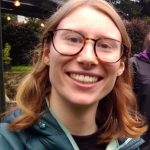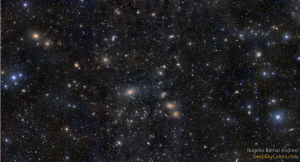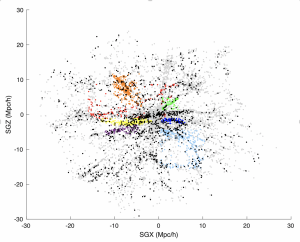October 4, 2021, by Prof Meghan Gray
Grace’s summer research internship: mapping the cosmic web
Guest post by Grace Gilbert (4th Year MSci Physics student) who recently spent time on a funded summer research placement in the Nottingham astronomy research group working with Prof Alfonso Aragón-Salamanca. As previously described in this blog, many of our undergraduate students gain valuable resaerch experience by working on summer internships here or abroad. We regularly advertise opportunities in academia and industry, and support students throughout the year with activities advising them on how to apply.

This summer I completed a placement within the astronomy research group here at the University of Nottingham, focusing on massive galaxy clusters. Most galaxies exist within groups or clusters, with filamentary (threadlike) structures connecting them and feeding more galaxies into them. According to the current model, most large-scale clusters are formed through the merging of smaller clusters; in this case, studying filaments around young clusters like the Virgo cluster (our nearest galaxy cluster) should give us valuable insight into the formation and evolution of massive galaxy clusters.

Figure 1: This image, courtesy of R.B. Andreo, shows the centre of the Virgo cluster. https://apod.nasa.gov/apod/ap150804.html
To study these filaments, they must first be identified and so the aim of my project was to map the galaxies in the Virgo cluster using two different methods for finding the position. The first method used the redshift of a galaxy to find the recessional velocity (the velocity at which a galaxy is moving away from us) and then use Hubble’s law to find a line-of-sight distance. This method was used to find the previously identified filaments but comes with a significant amount of error, as it assumes that the recessional velocity of the galaxy is only due to the expansion of the universe and doesn’t consider the velocity due to galaxies moving around within the cluster.
The second method is a more accurate method and uses the Tully-Fisher relation, which tells us the luminosity of a spiral galaxy if the rotational velocity is known. Because objects further away appear dimmer, a distance can be calculated by comparing this luminosity with how bright a galaxy appears to us on Earth.
My first task was to find and plot all the galaxies and previously found filaments in the Virgo cluster using the redshift distances. I then compared these galaxies with the catalogue of Tully-Fisher distances to find all the galaxies within the Virgo cluster with a known Tully-Fisher distance. Using this information, I then made new plots of the Virgo cluster.

Figure 2: A plot of all the galaxies within the Virgo cluster using the redshift distances. The coloured points represent filaments that had previously been found, the black points show the Tully-Fisher galaxies, and the grey points represent all other galaxies.
My work shows that there are enough galaxies with known Tully-Fisher distances to allow us to map and study filaments around the Virgo cluster and that these Tully-Fisher galaxies do delineate filaments. This could therefore be a viable technique for studying the filaments of galaxy clusters in future research.
This summer studentship has been such a fascinating project and massive learning experience for me – as well as a crash course in galaxy clusters, I’ve learnt how to navigate, query, and use new software to combine information from multiple large databases (a much more difficult task than I expected!). The most valuable thing I’ve gained, however, was the confidence and knowledge to deal independently with a more open-ended project. Although challenging, it taught me to trust myself more, teach myself the tools I needed and how to effectively troubleshoot my own work. It also gave me more space to try things, for some of those things to fail and to learn from that, as well as giving me a taste of research and postgraduate study. I would definitely encourage other undergraduates to take part if they get the opportunity.
No comments yet, fill out a comment to be the first

Leave a Reply